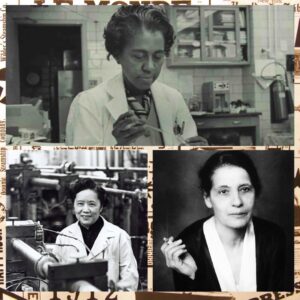
national science foundation, The Cardinal, scientific women.net
Women have dedicated their lives to the modern development of the world as we know it. The discoveries they have created are the cause to celebrate holidays such as International Women’s Day and Women’s History Month. While being discriminated against and overlooked time and time again, women have still managed to beat the odds and discover what man could not.
While we are now recognizing great women for the “sheros” they are, many of their ideas, findings and works have still gone unacknowledged. And many women have been poached of their most notable accomplishments only for their work to be credited to a man. While in times before us this may have been common, we should use this month to celebrate the accomplishments of the women whose works weren’t originally known to be their own.
Lisa Meitner
Jewish physicist Lisa Meitner changed the face of physics by writing a letter to the scientific journal Nature describing her finding on what was originally known to be an energetic impossibility. Through her discovery she was also able to describe where past scientists had failed to find the solution. The academic journal The Conversation describes her understanding of the subject:
“The whole ‘fission’ process can thus be described in an essentially classical [physics] way,” Meisner wrote.
Based on her work she found that while past scientists believed that filling atoms elements such as uranium with neutrons would only capture the neutrons or turn it into smaller particles such as radium. Her theory states that it was actually more like the element barium, which is a more feasible product for nuclear fusion. While her work should have made her a rising star in her field, at the time she was working in Berlin with colleague Otto Hahn.
When the Nazis arrived she was forced to leave and continue her work with Hahn in Stockholm. Though all significant findings were that of Meitner’s own accord when the team was prepared to publish the finding, Hahn couldn’t bear the reputational toll he would take from including a Jewish woman in the paper so he decided to publish without her. He went on to receive a Nobel Prize for her findings. After her passing she became a hot topic in women’s and gender history and also has a prize named after her at the nuclear physics department at Humboldt University. But while she was still with us she never was recognized for her tremendous impact in such a ground-breaking theory that is now known as the “Hahn Discovery.”
Alice Ball
Until 1915 a diagnosis of leprosy would lead to ostracism and often a lonely and isolated death. Alice Ball took an interest in this topic in the form of her master’s thesis on the kava plant. Harry Hollman took an interest in her wok and asked for her help in developing chaulmoogra oil, the only known treatment for leprosy. Hollman asked for help making improvements to the treatment by making it water soluble, thus making it easier to inject. Though Balls’ methods proved to be successful she died before she could publish her results.
Hollman ended up taking credit for the discovery in 1922, and her contribution to the project was lost until her work at the university was sought out and used to make the short film “The Ball Method,” that went on to be shown at the 28th Annual Pan African Film Festival. Her methods were able to heal the bodies and families of those affected by the disease. While in her time she was overlooked, her contribution is no longer unappreciated as James P. Harnisch describes the impact of her accomplishment in an article published by National Geographic.
“Ball’s discovery was very beneficial to alleviating the pain that was sustained by patients,” Harnisch said.
Chien-Shiung Wu
Chien-Shiung Wu was a nuclear physicist from Shanghai who went on to receive her doctorate from Berkeley. In 1944 she joined the Manhattan Project at the Substitute Alloy Materials lab at Columbia University. After the war she received a full-time position at Columbia and began studying beta decay. Throughout her career she spoke about her love for this topic and is even quoted in H. B. Newman and T. Ypsilantis’ “History of Original Ideas and Basic Discoveries in Particle Physics — Parity Violation.”
“Beta decay was … like a dear old friend. There would always be a special place in my heart reserved especially for it,” Wu said.
In 1956 theoretical physicists Tsung Dao Lee and Chen Ning Yang, who she began working with in order to devise a plan to disprove the law of parity. Her experiments and expertise on the subject allowed both Lee and Yang to receive Nobel prizes. Wu’s exemplary and crucial development of the proof necessary to prove the theory was unrecognized. Despite this injustice, Wu was able to continue to contribute to the world of medicine and science as a whole and was heavily decorated by the end of her career.
While we may now show our gratitude to the women whose work has helped to shape the course of our world, we must never forget who to thank for the foundation we are able to build on.